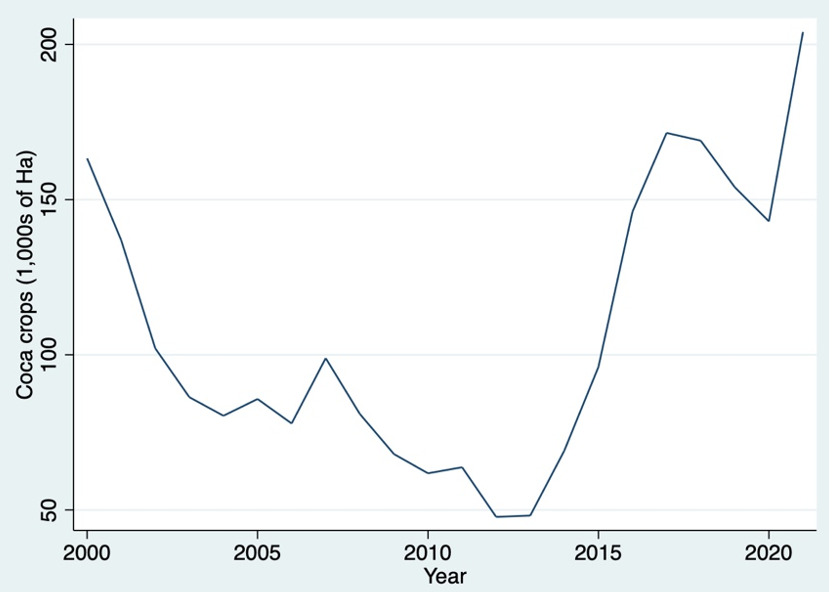
Announcements of future policies can have substantial unintended consequences and caused a surge of coca production in Colombia
What are the most effective ways to fight illegal drugs production, trafficking, and consumption? Over 50 years after Richard Nixon declared a “war on drugs” (in June 1971), academics, practitioners, and policy makers are still debating this question. With a focus on prohibition and criminal punishment over treatment and prevention, the war on drugs set America –and most of the world for that matter—on a counterproductive path. Indeed, most administrations since Nixon have continued, and oftentimes escalated, the punitive approach to addressing the problem of illegal drugs. For instance, the share of inmates in U.S federal prisons who were incarcerated for drug offences surged from 21 percent in 1980 to 52 percent in 2010.
The failure of prohibition
The war on drugs has indeed been a colossal failure (Baum 1996, Gray 2013). Since business disputes in illegal markets cannot be resolved by legal courts, prohibition encourages violence (Miron and Zwiebel 1995, Miron 1999, 2001, Chimeli and Soares 2017). Moreover, enforcement often backfires by creating violent power disputes (Dell 2015, Calderon et al. 2015), increasing the illegal profits (Clemens 2013), and encouraging retaliation rather than consolidating the rule of law (Abadie et al. 2013, Lessing 2017). A US representative survey conducted in 2001, 50 years after the declaration of the war on drugs, found that 83 percent of respondents say such a war failed (this figure is largely invariant of the respondent’s party affiliation) and 65 percent support ending it.
In hindsight, it is puzzling why efforts to curb illegal drugs’ production and trafficking have relied to a much lesser extent on incentives and regulation. One possible explanation is that poorly thought-out incentives can also have negative effects, especially if policy makers fail to anticipate how people would typically react or change their behaviour. Incentive-based polices that are announced prior to their implementation are particularly vulnerable to such unintended negative effects. Naturally, if certain benefits or costs from a new policy can be anticipated, people may behave in ways that undermine the intended objective of such policies.
In our recent research, we show that in the specific case of the war on drugs, poorly designed policies can have enormous social costs and large externalities (Prem et al. 2023). We focus on the case of Colombia, which produces 95% of the cocaine entering the US.
Wiping out the success of Plan Colombia
In 1999, the US and Colombia launched a joint counternarcotics programme called Plan Colombia. Under this initiative, America spent well over 10 billion dollars in reducing the supply of illegal drugs coming from Colombia, especially that of cocaine. At the start of the programme in 2000, Colombia had around 163,000 hectares of coca crops, the main precursor to the fabrication of cocaine. By 2013, the figure had gone down 71%, reaching 48,000 hectares (see Figure 1). By then, the evidence suggested that, albeit with ebbs and flows, Plan Colombia had been successful.
However, in 2021, the latest figure available from the estimates of the Colombia SIMCI project of the United Nations Office on Drugs and Crime (UNODC), coca-growing had grown to 204,000 hectares, a 325% increase relative to the 2013 all-time low. But what can explain this dramatic reversal? Our research suggests that the unprecedented expansion in coca cultivation is the result of an anticipation effect generated by the announcement of a future policy providing material incentives to replace growing coca with legal crops.
Figure 1: Evolution of coca crops in Colombia

Source: Colombia SIMCI project, UNODC.
A naïve announcement
In October 2012 the government of Colombia and the Revolutionary Armed Forces of Colombia (FARC from the Spanish acronym) started formal peace negotiations in Havana. One of the most important milestones of the negotiations, prior to reaching the final accord in 2016, was a partial agreement on how to tackle drug production and trafficking. On May 16th, 2014, the negotiating parties held a joint press conference in which they announced that, after reaching a peace agreement, the government was going a Comprehensive National Programme for the Substitution of Crops for Illicit Use “in order to generate material conditions [emphasis added] and intangible conditions of well-being and good living for populations affected by crops for illicit use, in particular for rural communities in situations of poverty that currently derive their subsistence from these crops.”
We posit that, by providing future material compensations to growers of illicit coca crops without specifying any detail about eligibility, such an announcement was largely accountable for the surge in coca growing, experienced ever since 2014. We test this idea by looking at the evolution of coca growing before and after the announcement in two types of areas. First, we compare places suitable to growing coca (according to geo-ecological factors associated with their soil and weather that vary within municipalities) to the rest of the country. This comparison exploits variation in the cost-advantage to growing coca before the policy was announced, and thus differential ability to respond to the anticipated benefits from growing coca. Second, we compare places that meet the criteria that the announcement specified for the targeting of future material benefits (namely high poverty levels and a history of coca crops) to the rest of the country. This comparison exploits differences in the expected access to material benefits.
Main findings and implications
We find a large differential increase in the area cultivated with coca in coca-suitable areas as well as in places with a higher probability of receiving material incentives for crop substitution. Specifically, after the 2014 announcement, a one-standard-deviation increase in coca suitability more than doubles coca growing relative to the pre-announcement mean. Moreover, if we increase by 10% the estimated probability of receiving the incentives for crop substitution relative to the mean, then the area of coca crops increases by 50% relative to the pre-announcement mean. Importantly, we document that the post 2013 surge in coca growing is not explained by the decision of the Colombian government to ban the aerial spraying of coca crops with herbicide in 2015.
Our results have implications for the way in which policies are discussed. For example, while making parliamentary debates public may promote accountability and provide key information for voters, it has the drawback of potentially creating “announcement effects” that can make policies ineffective or even have unintended harmful consequences. An illustrative example is the “Safer Neighbourhoods Gun Buyback Act of 2019,” which provides material incentives in exchange for firearms in the U.S.
Our findings do not imply that incentives and regulation are not a viable alternative to enforcement and prohibition in the fight against illicit crops. However, they highlight the importance of trying to understand ex ante all the potential behavioural responses and incorporating them in the design of policies. Specifically, the design of illicit crop substitution programmes should incorporate baseline estimations of illicit crop cultivation at very desegregated levels and should impose conditions for the delivery of material benefits for growers who decide to substitute their illicit crops.
References
Abadie, A, M Acevedo, M Kugler, and J Vargas (2013), “Inside the war on drugs: Effectiveness and unintended consequences of a large illicit crops eradication program in Colombia,” Unpublished manuscript.
Baum, D (1996), “Smoke and mirrors: The war on drugs and the politics of failure”, Little, Brown Boston.
Calderón, G, G Robles, A Díaz-Cayeros, and B Magaloni (2015), “The beheading of criminal organizations and the dynamics of violence in Mexico,” Journal of Conflict Resolution, 59: 1455–1485.
Chimeli, A B, and R R Soares (2017), "The Use of Violence in Illegal Markets: Evidence from Mahogany Trade in the Brazilian Amazon." American Economic Journal: Applied Economics, 9(4): 30-57.
Clemens, J P (2013), “Evaluating economic warfare: Lessons from efforts to suppress the Afghan opium trade,” Unpublished manuscript.
Dell, M (2015), “Trafficking networks and the Mexican drug war,” American Economic Review, 105: 1738–79.
Gray, M (2013), “Drug crazy: How we got into this mess and how we can get out”, Routledge.
Lessing, B (2017), “Making peace in drug wars: Crackdowns and cartels in Latin America”, Cambridge University Press.
Miron, J A (1999), “Violence and the US prohibitions of drugs and alcohol,” American Law and Economics Review, 1: 78–114.
Miron, J A (2001), “Violence, guns, and drugs: A cross-country analysis,” The Journal of Law and Economics, 44: 615–633.
Miron, J A and J Zwiebel (1995), “The economic case against drug prohibition,” Journal of Economic Perspectives, 9: 175–192.
Prem, M, J F Vargas, and D Mejía (2023), "The rise and persistence of illegal crops: evidence from a naive policy announcement", The Review of Economics and Statistics, 105(2): 344–358.



